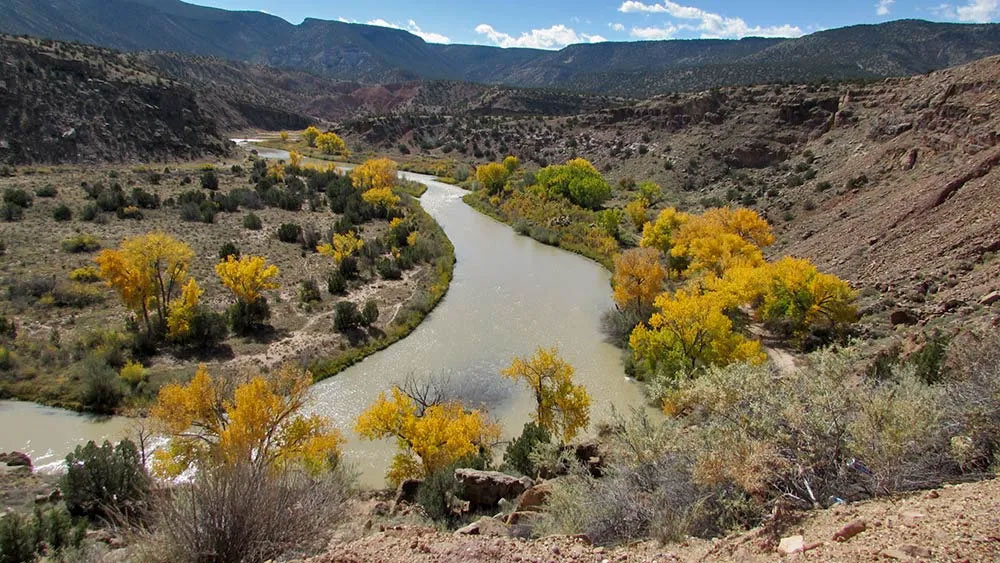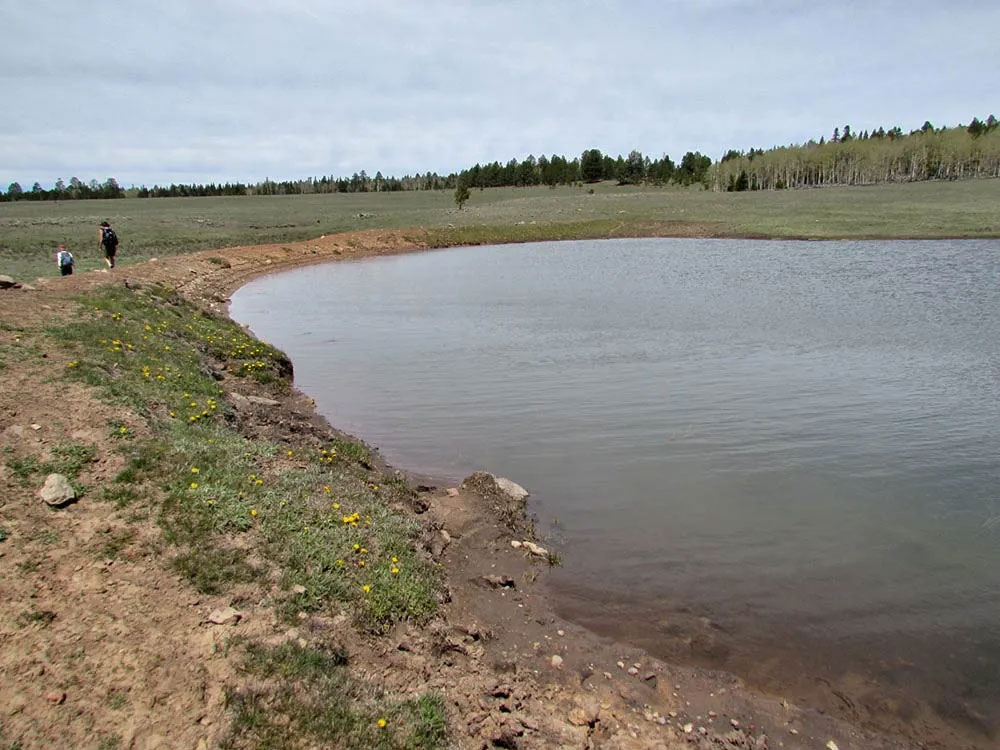|
Images Courtesy of Jessica Rath By Jessica Rath Isn’t it glorious to live close by a beautiful river? If you grew up here and lived here all your life, the Chama River sustained and nurtured you and for someone like me, who lived in big cities for most of her life, the river was a blessing and a friend. I love everything about it, the different sounds it makes, the various shades of blue and brown and grey, all the different critters one meets when one sits close by for a while and silently watches. I never knew there were so many different kinds of ducks! Buffleheads, mergansers, various teals, mallards, shovelers – they often came by, with cute babies in tow. And the fireflies! There’s hardly anything more magical than blinking, dancing fireflies at the river’s edge on a dark night. An unforgettable sight. When I did some research about the Tsama Pueblo, I finally learned where the name of the river came from. The Tewa people who lived in this region for hundreds of years before the Spanish settlers arrived had a different name for the river: they called it P’op’įgeh, which means “River-red-place” in Tewa. It’s an almost startling sight if you’ve never seen it. During monsoon time, when the water comes down in buckets, the river really turns red. But why is it called “Chama” now? Well, the Tewa called their pueblo Tsámaʔ ówîngeh, which means “Wrestling Pueblo Village”. It was right near the river, one of the many small villages in the area. By the 1600s, the Tewa had slowly moved away into larger settlements, and the Spanish settlers had slowly moved in. Over time, the name for the pueblo became the name for the river; maybe Tsáma (which became Chama) was easier to pronounce than P’op’įgeh for the new residents of the area. Last year, the river was extraordinarily full. You remember that the dam of the reservoir further upstream, El Vado Lake, needed to be repaired, and all the water had to be drained. For a while, Abiquiu Lake’s bridges and picnic tables were under water, and the Chama was just wild. The image below was taken in May of 2023 while the one underneath is taken from the same spot in 2017. And below the dam, the river can flow so quietly that it acts like a mirror. The cliffs, trees, rock formations, the clouds and the sky – everything is perfectly reflected. Even after I didn’t live right next to the river anymore, I’d often go on hikes that would take me near the Chama. Maybe it’s just negative air ions (NAIs), but I feel better when I’m close to the river, and I’m grateful for this beneficial gift. That’s why I was rather shocked when I read that the environmental advocacy organization American Rivers, which has worked for over 50 years to protect and restore rivers throughout the U.S., declared the rivers of New Mexico America’s most endangered rivers of 2024. Not a specific river or a stretch of a river, but every river in our state. Clean drinking water, irrigation, fish and wildlife habitat, rivers, streams, and wetlands are threatened because they lost federal protection. A U.S. Supreme Court decision from 2023, Sacket vs. Environmental Protection Agency, ruled that “only those relatively permanent, standing or continuously flowing bodies of water 'forming geographic[al] features' that are described in ordinary parlance as 'streams, oceans, rivers, and lakes' “[1] would fall under the Clean Water Act’s jurisdiction. This leaves New Mexico’s waters particularly vulnerable, because the state has such a large percentage of intermittent and ephemeral streams (96% of New Mexico’s streams according to the New Mexico Environment Department), as well as closed basins. Many streams run through arroyos, but only during the rainy season or for some time after snowmelt: they’re intermittent or ephemeral. [1] SACKETT v. EPA 20% of land area of the state are closed or endorheic basins, which means they don’t flow into other bodies of water, such as rivers or oceans, but drain internally. All these waterways have lost their protection and are in danger of pollution. So far, New Mexico doesn’t have its own surface water permitting program, one of only three U.S. states without one. Wastewater treatment plants, mines, industrial sites, development projects, etc. needed to get permits under the federal Clean Water Act, but the Supreme Court decision stripped the protection for small streams and wetlands, leaving them vulnerable.
“These rulings fly in the face of established science and ignore the value that small streams and wetlands have to their broader watersheds, communities, and economies, particularly in places with dry climates like New Mexico,” according to American Rivers. “The Clean Water Act was established in 1972 as a promise to communities across the country that we recognize the critical importance of clean water. The Sackett decision flies in the face of that promise,” said Tricia Snyder, rivers and waters program director for New Mexico Wild.[1] Governor Michelle Lujan Grisham and the state legislature are beginning to implement a comprehensive state permitting program that will protect all of the state’s rivers, streams, and wetlands, including those that are still protected by the EPA. $7.6 million have already been allocated to the program. This will make sure that critical wildlife habitat, as well as water sources for drinking water, irrigation, and recreation opportunities, will be secured for future residents of New Mexico, human and non-human. It’s extremely urgent to implement such a program, and so far, progress has been slow. So far, there’s not enough staff and not enough money. According to the Progressive Magazine, the program that is needed would require between $43 million and $54 million annually. In January, the state legislature approved the Land of Enchantment Legacy Fund, and in May the government released its new Climate Adaptation and Resilience Plan, which intends to strengthen water infrastructure, supply systems, and treatment facilities. Water quality is an extremely serious problem. If we want the Rio Chama to nurture many future generations, we need policies that can be implemented really soon. [1] One Year Post-Sackett
5 Comments
Sara Wright
6/21/2024 06:44:50 pm
I love that river and loved it the moment I saw her. Your pictures brought back so many memories....I walked to that river every morning before dawn I am deeply distressed to learn more about how endangered thees rivers are... Have we really forgotten that WATER IS LIFE FOR ALL? I named her Red Willow River and I knew nothing of the Tewa word but having seen her run red I remember - and dearly hope to see her again...Thank you for this informative article!
Reply
Jessica Rath
6/23/2024 08:32:29 pm
Thank you, Sara. Interesting that to you the river is a "she". I grew up in Germany, and in German, nouns are either masculine, feminine, or neutral. Rivers happen to be masculine -- "der Fluss" -- but it makes sense that it should be feminine. The fluidity and adaptability of a river would make it so. I love that river too.
Reply
Maire O'Neill
6/28/2024 06:51:38 am
Great article, Jessica.
Reply
Mark Keller
6/29/2024 05:09:07 pm
Excellent article and great writing. It summarizes the issue well. I found it shocking. I was unaware of this exposure. Thank you....I am going to become a supporter of the Abiquiu news as a result of this article.
Reply
Jessica
7/4/2024 03:23:04 pm
What a kind comment, Mark. Yes, it IS shocking that most of NM water is unprotected. I think our governor and the legislature are working to fix this.
Reply
Your comment will be posted after it is approved.
Leave a Reply. |
Submit your ideas for local feature articles
Profiles Gardening Recipes Observations Birding Essays Hiking AuthorsYou! Archives
October 2025
Categories
All
|







 RSS Feed
RSS Feed